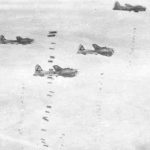
During World War II, the U.S. Army Air Corps heavy bomber fleets of B-17’s, B-24’s, and B-29’s were examples of some of the most advanced technology of the period. These four-engine aircraft were designed and built to deliver tons of bombs to a target, defend themselves against enemy fighter attacks, and get their 10- or 11-man crews back to base, if possible. According to a postwar study of bombardier training, the first bombardiers in the Air Corps were pilots interested in bombing or enlisted personnel who had shown some interest and skill in bombing. Eighteen men graduated from the first class of bombardier training in February 1941. By September 1945, 47,000 bombardiers had been trained by the Army Air Force Training Command.

Putting bombs on the target was the job of the aircraft bombardier. Not only did they release the bombs from the aircraft, but the bombardier had several other jobs on the aircraft. From the book The Man Who Flew the Memphis Belle: “Who was a bombardier? In addition to his duties as a bomb dropper and gunner, they would assist with other various duties on the aircraft such as perform oxygen checks or assist the navigator or radio operator with getting (location) fixes and their (mission) logs. Basically any of the basic duties that the other crew members could perform, so could the bombardier.” To see what the bombardier saw in a B-17, look at the bombardier’s “office”, courtesy of a B-17 appreciation site.
 This new flying hero role was then celebrated in film (Bombardier, 1943) and in song by famed composers Richard Rodgers & Lorenz Hart with their 1942 tune The Bombardier Song, found in the National Air & Space Museum Library Bella C. Landauer sheet music collection. As the cover notes, all song royalties went sent to the Army Air Forces AID Society Trust Fund. Then as now, we should do what we can to support all of our veterans who served their country, through peace and war.
This new flying hero role was then celebrated in film (Bombardier, 1943) and in song by famed composers Richard Rodgers & Lorenz Hart with their 1942 tune The Bombardier Song, found in the National Air & Space Museum Library Bella C. Landauer sheet music collection. As the cover notes, all song royalties went sent to the Army Air Forces AID Society Trust Fund. Then as now, we should do what we can to support all of our veterans who served their country, through peace and war.
This post was written by Chris Cottrill, Head Librarian at the National Air and Space Museum Library.

One Comment
What a great article Chris. You said it all in your last line when you said “then as now should do what we can to support all of our veterans”.
I come from a long line of veterans and my dad was an aviator in the military. In your article you describe the many functions of the Bombardier. I had no idea they could perform so many tasks.
as a piano and Music Theory Online teacher my knowledge of war aircraft is extremely limited however I had the opportunity in London England to go through some of the aviation museums with my dad. It is a memory that I treasure.
Thanks again Chris for great post. I found it extremely interesting. I hope you don’t mind if I send some traffic your way in sharing some of my friends and colleagues.